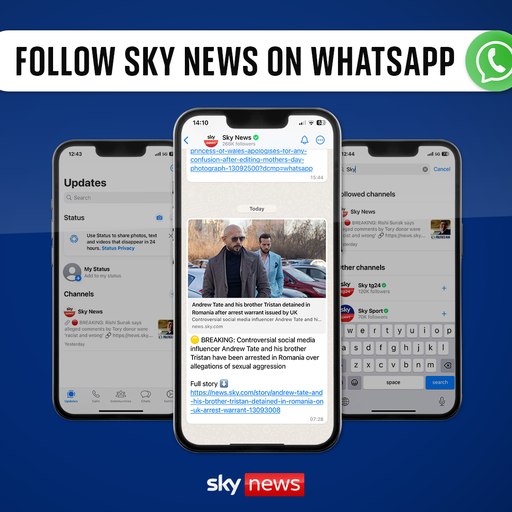Hassan Nasrallah was the target of recent Israeli attacks on the Lebanese capital, but it is not clear whether the leader of the Iran-backed militant group survived.
A passionate and fiery orator, Nasrallah is the leader of the Shia political and military faction Hezbollah.
The secretary general of Hezbollah is considered by many to be the single most powerful individual in Lebanon with as many as 100,000 fighters at his disposal and members of his group being MPs as well.
What is Hezbollah?
Image: A picture of Hassan Nasrallah during a funeral for a Hezbollah member. Pic: Reuters
Nasrallah was born in Beirut in 1960, where he was described as a devout and motivated student of Islam.
He joined Hezbollah in 1982, the year it was formed and rose through its ranks.
The 64-year-old has led Hezbollah into wars against Israel and taken part in the conflict in neighbouring Syria.
More on Hezbollah
Related Topics:
Under his leadership, the group has been transformed into a regional military and political power.
Nasrallah cemented Hezbollah as an archenemy of Israel, seeking deeper alliances with Shia religious leaders in Iran and Palestinian militant groups like Hamas.
Advertisement
Nasrallah holds the title of sayyid, an honorific meant to signify the Shia cleric’s lineage dating back to the Prophet Muhammad.
Nasrallah has countless followers across the Arab and Islamic world, but he is viewed as an extremist in much of the West.
Image: People watch Nasrallah delivering a televised address in Beirut. Pic: Reuters
Despite the power he wields, Nasrallah lives in hiding for fear of an Israeli assassination attempt.
After the most recent attack, many of his followers will fear that that worry has become a reality.
Despite suspiciously rapid statements that Nasrallah was “safe” there has not been an update since, and there is confusion over the fate of the Hezbollah leader.
The blast site is so large, it will take time for rescue workers to find the dead. The number of civilians killed is likely to rise considerably.
Spreaker This content is provided by Spreaker, which may be using cookies and other technologies. To show you this content, we need your permission to use cookies. You can use the buttons below to amend your preferences to enable Spreaker cookies or to allow those cookies just once. You can change your settings at any time via the Privacy Options. Unfortunately we have been unable to verify if you have consented to Spreaker cookies. To view this content you can use the button below to allow Spreaker cookies for this session only.
Enable Cookies Allow Cookies Once
👉 Click to subscribe to the Sky News Daily wherever you get your podcasts 👈
How did he rise to power?
Born to a poor Shia family in Beirut’s impoverished suburb of Sharshabouk, Nasrallah was later displaced to south Lebanon.
After studying theology, he joined the Amal movement, a political and paramilitary organisation, before joining Hezbollah in the year it was created.
Hezbollah was formed by Iranian Revolutionary Guard members who travelled to Lebanon in the summer of 1982 to fight invading Israeli forces.
Image: Pic: Reuters
It was the first group that Iran backed and used as a vehicle to export its brand of politics.
Nasrallah built a base of power as Hezbollah grew to be a part of the Axis of Resistance.
Two days after its then leader, 39-year-old Sayyed Abbas Musawi, was killed in an Israeli helicopter gunship raid in south Lebanon, Hezbollah chose Nasrallah as its new secretary general in February 1992.
Under Nasrallah’s leadership, Hezbollah is credited with leading the war of attrition that led to the withdrawal of Israeli troops from south Lebanon in 2000.
Follow Sky News on WhatsApp
Keep up with all the latest news from the UK and around the world by following Sky News
Tap here
After this victory, his status rose and was further cemented in 2006 when Hezbollah fought Israel to a stalemate during the 34-day war.
However, his popularity took a hit when Syria’s civil war erupted in 2011 and Hezbollah fighters rushed in and sided with Assad’s forces – even as he was ostracised by the Arab world.
Role in the Israel-Hamas war
A day after the 7 October attacks in Israel, Hezbollah began attacking Israeli military posts along the border and calling it a “backup front” for Gaza.
Tit-for-tat strikes have been traded almost daily since, and over the past weeks, as tensions have risen further, Nasrallah has tried to strike a defiant tone even as Israel strikes again and again at his organisation.
After Israel announced a new phase in the conflict looking toward its northern border, a series of pager and radio explosions rocked Lebanon, seemingly aimed at Hezbollah members.
They kickstarted the most recent waves of attacks on Lebanon.
Source : Sky News










